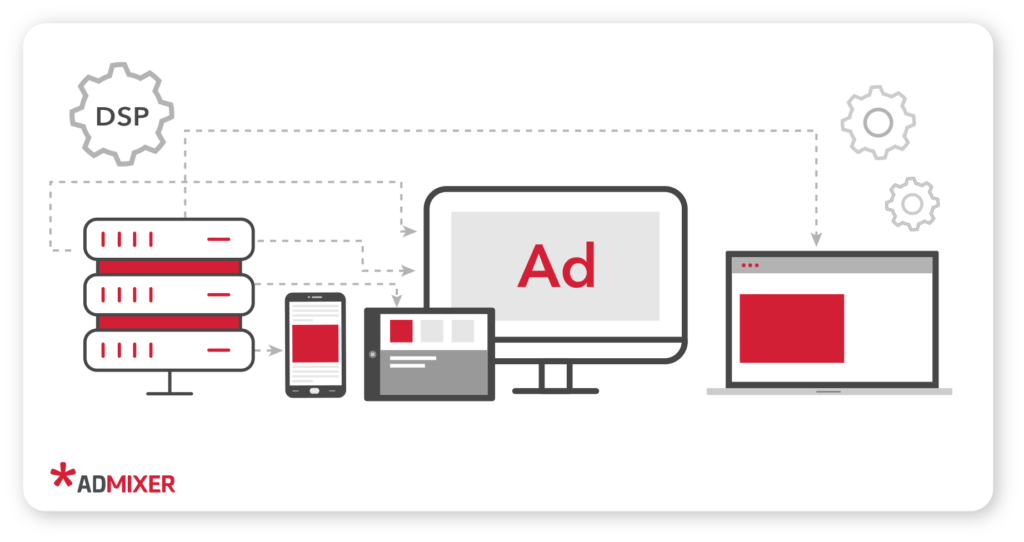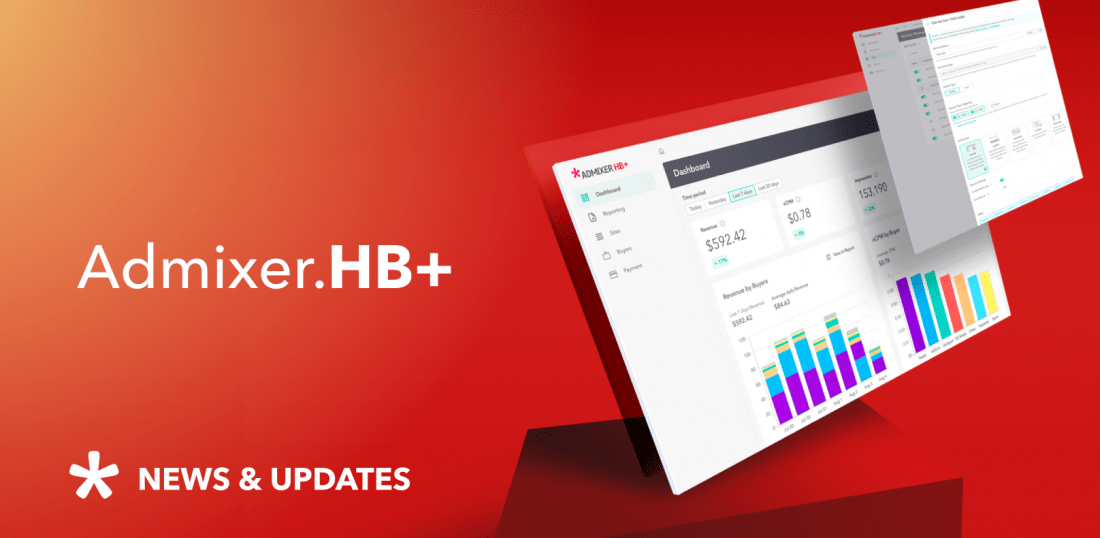
What is a Demand Side Platform: The DSP Role in Media Buying and How to Choose the Right Platform
If you want to expand the reach of your digital campaigns and get access to diverse audiences of websites, apps, games, and CTV — you need programmatic.
Media buying in this part of the internet may feel drastically different, especially if you got used to launching promotions in walled gardens, like Facebook. There all the necessary tools are built-in and readily available on the platform. In contrast, a programmatic ecosystem requires its own instrument, a demand-side platform (DSP).
- Why do you need a demand-side platform?
- What is a demand-side platform?
- Who needs a DSP?
- How does DSP advertising work?
- Must-haves of DSP platforms
- Cost-effective bidding
- Data tools
- Creative management platform
- Integrations
- User management
- Optimization and suggestions
- Reporting and statistics
- Perks of DSP advertising
- Unified dashboard and automated media buying
- Advanced features for data managements
- Transparency and anti-fraud tools
- Effective targeting
- Brand safety
- Consolidated analytics and reporting
- Key difference of ad network vs. DSP
- Self-Service Vs Full-Serviced DSP
- Full-service (managed) DSP
- Self-service DSP
- Wrap up
Why do you need a demand-side platform?
The modern programmatic marketplace is a lot like stock exchanges. Ad spaces are traded automatically through the system of centralized ad exchanges in real-time. Similarly to stocks, if you need an ad slot, you cannot access the exchange directly and need an intermediary. In the digital advertising world, instead of brokers, media buyers use their own version of middlemen, programmatic SaaS solutions — demand-side platform (DSP).
What is a demand-side platform?
DSP or demand-side platform is software that allows advertisers to access multiple sources of inventory, such as CTV, mobile apps, games, websites, podcasts, and streaming platforms. Advertisers can comfortably manage ads on various platforms through a single interface.
Demand-side platforms enable media buyers to participate in the auction, and provide data tools to optimize bidding and targeting.
Who needs a DSP?
Freelancers or small-sized businesses rarely use DSP. Usually, it is employed by a media buying department in a company, a marketing team, or an agency. Depending on the user, the demand-side platform can serve different goals and objectives.
- In-house teams use DSP to launch programmatic campaigns and advertise their products and services. Demand-side platform allows them to keep tabs on their customer base, divide them into remarketing groups based on the behavior and LTV, and get advanced statistics on user interaction and multi-touch attribution. DSP allows marketing teams to own their data and comfortably activate it or use it for promotions.
See In-House AdTech Stack if you need to cover all media buying needs with one solution.
- Ad agencies use DSP to advertise on behalf of their clients. For a commission, they help craft an advertising strategy, select the most effective audiences, inventory for targeting, and address any arising performance issues. They have to provide routine cost and performance assessments to their clients, and a proper DSP usually has a reporting module for that.
Check Agency Tech Stack designed for large agencies with multiple advertisers.
How does DSP advertising work?
Instead of the limited insight that you would normally get from the advertising cabinet of walled gardens, DSP provides a really deep insight into your ad spend.
DSP usually includes tools to manage ads across a variety of platforms and all possible ad formats.
To give advertisers the ability to bid on ad spaces in real-time, a demand-side platform usually connects to ad exchanges that work like stock exchanges for ad inventory. DSPs also connect to supply-side platforms (SSPs), which frequently work as exchanges but concentrate on gathering publishers’ inventory of particular formats or geo.
Must-haves of DSP platforms
You can’t just choose a random demand-side platform. DSPs come in different shapes and colors, it is a diverse marketplace, with each segment of DSPs responsible for a particular goal or niche. Still, a proper DSP must have a set of data and ad management tools that can ensure appropriate targeting and control over the advertising campaigns. Let’s review the key components modern DSPs should have.
Cost-effective bidding
Regardless if you are advertising a small flower shop or a big electronics brand, your advertising has to be cost-effective. Therefore, it is critical that DSP represents an advertiser’s interests and not just upscale owned inventory of some ad exchange. DSP should provide straight-forward access to bidding and let you review all of the commissions and prices that go into the auction.
It is also important that your DSP gives you a choice of the second-price auction or first-price auction, this way, you can choose an optimal media trading strategy that can save a lot of your ad spend.
Data tools
One of the best features a DSP can provide is built-in tools to manage advertiser’s data. Data is the most valuable asset for the brand. It gives a full understanding of who the customers are, their demographics, interests, buying preferences, and behavior on every touchpoint with the brand.
DSP should be able to gather and store data from the campaigns to use it for further promotion. Ideally, a DSP should have a built-in DMP that can give advertisers access to onboarding data from the outside source, consolidating it, and constructing narrow user segments for targeting.
“The DMP module is a great tool for audience planning. It allows us to make inventory purchasing decisions based on data rather than on intuition or previous experience.”
Grigoriy Shpak
Head of PPC at GroupM
Creative management platform
In today’s digital advertising, making and deploying an ad creative is impossible without an up-to-date creative management platform (CMP).
This tool would allow publishers to quickly produce in-demand creative based on a rich library of templates. CMP will enable advertisers to focus on scale and A/B testing instead of worrying about adjusting creatives for ad serving on different platforms. CMP is a SaaS solution that is frequently offered as a module with DSP where you pay only for the delivered impressions.
With it, instead of contracting a third-party provider, advertisers can assemble their rich media interactive creative on the go and get real-time statistics on its performance.
Integrations
A demand-side platform without the wealth of integrations is a shoemaker without shoes. A good DSP provides access to the diverse inventory through integrations with numerous SSPs and ad exchanges. It requires constant vetting of old and new supply partners, negotiating contracts, and billing. By canceling old partnerships and plugging-in new integrations DSPs ensure the quality of traffic, higher bid/win ratio, and reduce latency and possible ad serving discrepancies.
Admixer DSP is connected to 100+ top SSPs and thematic ad networks: InMobi, Fyber, IronSource, Unity, etc. It also has a connection to main ad exchanges: Google AdX, BidSwitch, Rubicon, etc.
User management
Your DSPs should have the functionality of setting up accounts with a different access level. As I mentioned before, DSP can be used by an in-house marketing team or an ad agency that manages multiple clients’ campaigns.
For the agency, these capabilities are necessary to let clients review their campaigns’ real-time results without peaking into their counterparts’ data. This feature can also be useful for the in-house team if it handles several projects’ campaigns and does want a data spillover between the departments.
Optimization and suggestions
Programmatic is an extremely sophisticated marketplace, and even the most experienced media buyer sometimes can miss an important new factor in the equation. An adequate DSP won’t leave an advertiser in the darkness and will automatically offer useful suggestions.
Usually, if you select your product category, the demand-side platform would offer the most suitable inventory for your ad. Additionally, DSP can make recommendations on the ad format, behavioral targeting and will notify the advertiser if the performance indicators have fallen to critical levels.
Reporting and statistics
This feature seems obvious, but it certainly worth reiterating. DSP has to provide advertisers with exhaustive real-time information on the performance of ad campaigns.
It should have a user-friendly interface where you can quickly access CTR, coverage, ad spend of the active campaigns. Additionally, it should provide an ability to access the effectiveness of a particular inventory or an audience group. Finally, DSP should be able to craft recurrent reports in the friendly downloadable format on all the valuable performance metrics.
Perks of DSP advertising
Modern digital advertising is becoming more and more complex and data-driven. In contrast to end-to-end interfaces of walled gardens, advertising through programmatic requires a more thoughtful approach to data. DSP is a prerequisite for entering this landscape that unlocks its perks of precision and efficiency.

Unified dashboard and automated media buying
In the previously dominant ad network model, advertisers had to juggle a variety of interfaces to purchase impressions across different platforms and individually set them up. Now a single DSP can provide access to multi-million audiences across websites, apps, and other environments. Instead of manual configuring, demand-side platforms offer automatic media buying based on pre-set preferences on all available inventory.
Advanced features for data managements
Built-in DMP helps reduce data loss during integrations. Data is the most viable asset, allowing advertisers to get granular reporting, define narrow segments of the audience, and set persona-centered campaigns. A good DSP with a built-in DMP can activate data in all possible systems and give access to various local sources of data and global data exchanges.
Admixer.DSP has very flexible options for managing data, collecting and transferring it to other DSPs, and activating it in Google and Facebook, uploading raw data, transmitting data packets, and automating data processes. Advertisers can also sell data through our DSP.
Transparency and anti-fraud tools
Previously a programmatic marketplace was plagued with untransparent supply chains and various types of misrepresented traffic. However, now the industry has implemented a fraud-proof standard ads.txt and app.ads.txt.
It lets buyers check if the platform is the authorized sellers of the inventory and purchased only from the verified platforms. A proper demand-side platform enables you to filter out inventory sources without this standard. A DSP should also provide real-time granular reporting on the traffic source, which allows you to detect and disconnect compromised publishers quickly.
Effective targeting
With the right type of inventory, enriched with the 1st-party publisher data, DSPs can provide targeting criteria that are possible only in programmatic. This may include:
- Social/demographic — ability to set up targeting for a specific social demographic audience or interest.
- Context — targeting specific content categories.
- Environment — ability to choose web, in-app, CTV, etc.
- Geo — set targeting by cities / regions. Admixer.DSP allows not only to create city lists, but also set the point and radius of the advertisement using a map or setting latitude and longitude.
- IP — the ability to target a campaign on a specific IP address or list of IP addresses.
- Device — this type of targeting allows you to select the type of device on which your ad will be placed, for instance, target by manufacturer or model.
- Connection type and provider — the ability to target by connection type (2G, 3G, 4G, Wi-fi, Ethernet, Cellular Unknown, Unknown), as well as by provider.
- Operating systems — setting this targeting will allow you to display on a given
- Browser — the ability to target the required browser or exclude it.
- Screen extension — the ability to target a certain extension, for cases when you display a non-standard format, that would lose in quality on smaller screens.
- Day / Time — if necessary, you can set specific periods of time and day. With such settings, the campaign will be active only on the day and the time specified in this targeting. For example, you can target your customers on the nights of the weekend.
- Audience Groups — targeting based on groups gathered on owned media or previous campaigns.
Brand safety
In walled gardens, like Facebook, ads appear next to user-generated content that can be inappropriate/repulsive and hurt brand image.
A demand-side platform allows advertisers to choose the source of the impressions and veto any content categories that can damage the brand’s reputation. When setting DSP targeting, one can select to exclude certain types of websites. For instance, you can choose not to advertise on news sites, not appear next to potentially provocative materials.
Consolidated analytics and reporting
Even if you simultaneously run your sneakers’ campaigns on the fitness app, natively on the healthy lifestyle websites, and on CTV devices before sports streaming, you can get a unified report. DSP can consolidate data from different inventory sources, ad exchanges, and SSPs.
On top of that, demand-side platforms allow you to track campaign performance in real-time. With this feature, you can switch off underperforming profiles and optimize without losing ad spend.
Key difference of ad network vs. DSP
Ad Network contracts a group of publishers and sells the ad slots on their behalf. Modern ad networks are usually vertical, concentrating on a particular content category, and focusing on premium inventory or traffic from certain geos.
There are ad networks that gather the inventory of particular formats, for instance, casual-games publishers. Ad networks can provide advertisers with a trading desk for targeting their inventory. This may resemble a demand-side platform, but only at the first glance.
Admixer.Network – solution for ad network creation and management that allows you to issue trade desks to advertisers for exclusive deals and targeting on the premium inventory. The remnant traffic can be sold by various programmatically sold to connected demand partners.
DSP is drastically different from the ad network. It is a SaaS solution that provides access to countless sources of inventory and has some built-in capabilities for ad and data management. The network is just like a small retail shop selling home-grown inventory, while DSP is a big e-commerce platform that offers traffic from the most diverse sources.

Self-Service Vs Full-Serviced DSP
Depending on your expertise, resources, and objectives, you can choose DSP with different functionality. There are two main types of DSPs full-service and self-service:
Full-service (managed) DSP
Full-service (or managed) DSPs have all the capabilities and can perform all the functions I described above. Advertisers can pick ad formats, the source of traffic, set up intricate targeting rules, and manage the creatives.
The notorious feature of full-serviced DSP is that an advertiser does not have direct access to most of the features.
All of the operations are done by a dedicated ad ops, a programmatic expert who manages and optimizes campaigns for the advertiser. Full-service DSP is a great option if you need programmatic but don’t want to outsource this function completely and have additional controls. It is a good option for brands that don’t have a big marketing team, not to mention a programmatic media buyer.
In the case of the full-serviced DSP, you heavily rely on the account manager who assists you each step of the way with planning campaigns and allocating budgets, tuning targeting, and controlling performance metrics.
As a rule, this kind of demand-side platform costs more and provides extra help for those who are just starting their journey in programmatic advertising and want to tread the waters. Account managers usually provide 24/7 support and useful tips on interpreting statistics and making sense of data and metrics.
| Pros of full-service DSP | Cons of full-service DSP |
| Round the clock assistance with targeting, ad management, and billing | Higher fees |
| No need to have extensive skills in media buying or knowledge of programmatic | Limited control over your campaigns |
| All settings and monitoring of the campaign are carried out by managers | You need to contact a manager to resolve all the common problems, no access to manual configuration |
| An account manager that optimizes campaigns for you and can resolve any arising technical queries |
Self-service DSP
Self-service DSP allows you to launch programmatic campaigns on your own without any guidance and supervision. This option significantly reduces costs for operating programmatic campaigns.
Advertisers can set, control, and optimize campaigns on their own, having full ownership over their data and digital presence. On the other hand, in self-service DSP, advertisers have to do campaign planning, bidding, and budgeting on their own.
However, it usually has smart algorithms that suggest good targeting and inventory options and provide an intuitive interface where a campaign can be created within a few clicks.
| Pros of self-service DSP | Cons of self-service DSP |
| Smaller commissions for use | You need to have a basic skill set before creating your first campaign |
| Ability to launch campaigns on your own schedules and have more control over data and inventory | You need to control and optimize the performance of your campaigns without outside help and advice |
| Ability to connect traffic sources of your choice | More duties and routine tasks |
Wrap up
A demand-side platform is a key that unlocks programmatic advertising and lets you advertise on the website, apps, podcasts, streams, and many other platforms that can give access to niche audiences, unreachable by other channels. A good DSP needs to have a set of instruments to be effective for advertising.
First of all, it is various integrations to SSPs, ad exchanges and networks, that give access to diverse inventory and first-party data. Second, it has built-in functionalities for bidding and data management that allows you to get the most appropriate inventory for targeting and pick narrow audience segments.
Admixer.DSP is a platform that has all the described above features and has various modules that can be added for the needs of different business models. Specifically for agencies, we offer an Agency Tech Stack, DSP+ modules to effectively conduct campaigns as an agency, as well as Ad Tech Stack, DSP+ additional modules to effectively in-house programmatic media buying.




